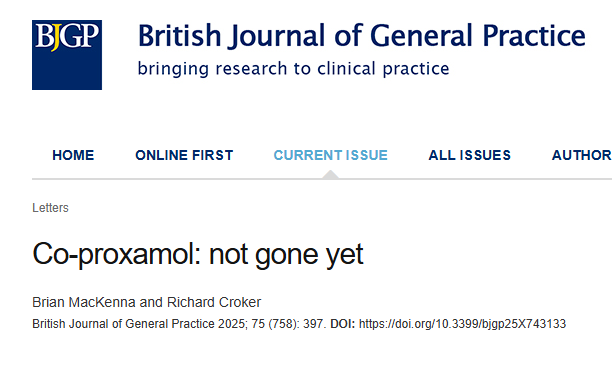Co-proxamol: not gone yet. What can you do?
- Posted:
- Written by:
- Categories:

Co-proxamol was withdrawn for safety reasons in 2005, yet our new research letter in the British Journal of General Practice shows that prescribing continues in both primary and secondary care, sometimes with tragic consequences. Co-proxamol carries significant risks of accidental and intentional overdose, and safer alternatives are available.
The full letter is reproduced at the end of this blog. But the main message is simple: co-proxamol prescribing hasn’t gone away, and in this blog we briefly describe how OpenPrescribing can help you review and audit your own co-proxamol prescribing.
General Practice
OpenPrescribing has a dedicated co-proxamol measure. We encourage practices, PCNs, and ICBs to review their current prescribing, and consider whether safer alternatives can be used.
Hospitals
We’ve just launched a brand new OpenPrescribing Hospitals measure for co-proxamol. This builds on our suite of measures for low value medicines in hospitals. Read our recent blog on low value medicines in hospitals, which explains why hospital use of these medicines matter for patient safety and NHS resources.
Conclusion
Co-proxamol is a clear example of “legacy” low-value prescribing that persists years after national withdrawal. Tools like OpenPrescribing make it easy for clinicians in both primary care and hospitals to identify, review and address this kind of prescribing, improving care and safety for patients.
Full research letter
The following is reproduced from our recent letter in the British Journal of General Practice:
DOI: https://doi.org/10.3399/bjgp25X743133
Dear Editor, we read your editorial on co-proxamol with great interest.1 This is not just a legacy prescribing issue; it is a patient safety issue that continues today. Co-proxamol deserves renewed attention, not just as a footnote in pharmacovigilance history, but as a current and addressable safety risk.
Despite the formal withdrawal of its marketing authorisation nearly two decades ago, co-proxamol prescribing persists, with tragic results. Since its withdrawal, over 200 people have died due to co-proxamol poisoning 2 and new initiations of co-proxamol are occurring.3 In the last year alone, NHS spending on co-proxamol was approximately £2 million,4 roughly half of the cost in the last year before regulatory action.5
Our group delivers OpenPrescribing.net, which provides online dashboards of measures of prescribing quality and safety for every general practice in England. We have a dedicated measure of co-proxamol and we encourage all practices to review their co-proxamol prescribing, which is also called for in this year’s NHS planning guidance 6.
Co-proxamol’s ongoing use, despite robust regulatory action and sustained reductions in prescribing, presents an opportunity to revisit how such withdrawals are implemented. General practice has made major progress, but prescribing levels suggest further system-level attention is needed to complete the job.
References
- Lawson E. Prescribing in good faith. Br J Gen Pract. 2025;75:291. doi: 10.3399/bjgp25X742677
- Deaths related to drug poisoning in England and Wales - Office for National Statistics. 2024. https://www.ons.gov.uk/peoplepopulationandcommunity/ birthsdeathsandmarriages/deaths/bulletins/ deathsrelatedtodrugpoisoninginenglandandwales/ 2023registrations (accessed 15 July 2025)
- NHS Business Services Authority. CCG summary prescribing data for low value medicines.
- Bennett Institute for Applied Data Science. OpenPrescribing:co-proxamol analyse page. OpenPrescribing.net. https://openprescribing.net/analyse/ #org=CCG&numIds=0407010Q0&denom=total_list_size& selectedTab=summary (accessed 15 July 2025)
- Prescription Cost Analysis - England, 2006. NHS England Digital. https://digital.nhs.uk/data-and-information/publications/statistical/prescription-cost-analysis/prescription-cost-analysis-2006 (accessed 15 July 2025)
- England NHS. NHS England » 2025/26 priorities and operational planning guidance. https://www.england.nhs.uk/long-read/2025-26-priorities-and-operational-planning-guidance/ (accessed 15 July 2025)


